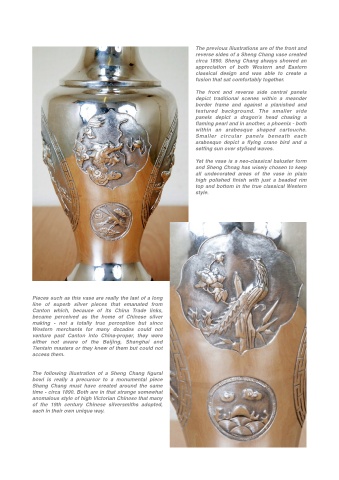Page 629 - Chinese SIlver By Adrien Von Ferscht
P. 629
The previous illustrations are of the front and
reverse sides of a Sheng Chang vase created
circa 1890. Sheng Chang always showed an
appreciation of both Western and Eastern
classical design and was able to create a
fusion that sat comfortably together.
The front and reverse side central panels
depict traditional scenes within a meander
border frame and against a planished and
textured background. The smaller side
panels depict a dragon’s head chasing a
flaming pearl and in another, a phoenix - both
within an arabesque shaped cartouche.
Smaller circular panels beneath each
arabesque depict a flying crane bird and a
setting sun over stylised waves.
Yet the vase is a neo-classical baluster form
and Sheng Chnag has wisely chosen to keep
all undecorated areas of the vase in plain
high polished finish with just a beaded rim
top and bottom in the true classical Western
style.
Pieces such as this vase are really the last of a long
line of superb silver pieces that emanated from
Canton which, because of its China Trade links,
became perceived as the home of Chinese silver
making - not a totally true perception but since
Western merchants for many decades could not
venture past Canton into China-proper, they were
either not aware of the Beijing, Shanghai and
Tientsin masters or they knew of them but could not
access them.
The following illustration of a Sheng Chang figural
bowl is really a precursor to a monumental piece
Shang Chang must have created around the same
time - circa 1890. Both are in that strange somewhat
anomalous style of high Victorian Chinese that many
of the 19th century Chinese silversmiths adopted,
each in their own unique way.

